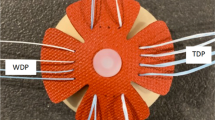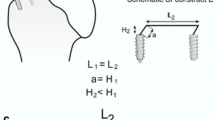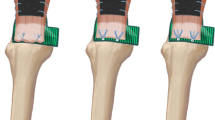Abstract
Purpose
To evaluate whether the use of knotless lateral anchors in a suture bridge construct produces better contact area and pressure parameters than a suture bridge construct with standard lateral anchors that require knots or a double-row repair. The hypothesis was that knotless lateral anchors would produce better contact area and pressure parameters than the other two constructs.
Methods
A total of fifteen matched pairs of cadaveric shoulders were divided into three groups. In Group 1, a suture bridge using knotless anchors for the lateral row was performed on five shoulders. A suture bridge using standard lateral row anchors that require knots was performed on the contralateral shoulders. In Group 2, suture bridge with knotless lateral row anchors was compared with double-row repair. In Group 3, suture bridge using standard lateral row anchors was compared with double-row repair. The contact conditions of the rotator cuff footprint were measured using pressure-sensitive film.
Results
There were no statistically significant differences between any of the techniques regarding contact area F(2, 15.7) = 3.09, P = 0.07 or mean contact pressure F(2, 15.1) = 2.35, P = 0.12. A post hoc power analysis suggests differences between techniques are likely less than 91–113 mm2 for area and 0.071-0.089 N for pressure.
Conclusions
The use of knotless anchors in the lateral row of a suture bridge repair did not increase the footprint contact area or contact pressure when compared to a suture bridge repair requiring knots laterally or to a double-row repair.




Similar content being viewed by others
References
Ahmad CS, Stewart AM, Izquierdo R et al (2005) Tendon-bone interface motion in transosseous suture and suture anchor rotator cuff repair techniques. Am J Sports Med 33:1667–1671
Baums MH, Buchhorn GH, Spahn G et al (2008) Biomechanical characteristics of single-row repair in comparison to double-row repair with consideration of the suture configuration and suture material. Knee Surg Sports Traumatol Arthrosc 16:1052–1060
Bishop J, Klepps S, Lo IK et al (2006) Cuff integrity after arthroscopic versus open rotator cuff repair: a prospective study. J Shoulder Elbow Surg 15:290–299
Brady PC, Arrigoni P, Burkhart SS (2006) Evaluation of residual rotator cuff defects after in vivo single- versus double-row rotator cuff repairs. Arthroscopy 22:1070–1075
Burks RT, Crim J, Brown N et al (2009) A prospective randomized clinical trial comparing arthroscopic single- and double-row rotator cuff repair: magnetic resonance imaging and early clinical evaluation. Am J Sports Med 37:674–682
Busfield BT, Glousman RE, McGarry MH et al (2008) A biomechanical comparison of 2 technical variations of double-row rotator cuff fixation: the importance of medial row knots. Am J Sports Med 36:901–906
Caldwell GL, Warner JP, Miller MD et al (1997) Strength of fixation with transosseous sutures in rotator cuff repair. J Bone Joint Surg Am 79:1064–1068
Chhabra A, Goradia VK, Francke EI et al (2005) In vitro analysis of rotator cuff repairs: a comparison of arthroscopically inserted tacks or anchors with open transosseous repairs. Arthroscopy 21:323–327
Cole BJ, ElAttrache NS, Anbari A (2007) Arthroscopic rotator cuff repairs: an anatomic and biomechanical rationale for different suture-anchor repair configurations. Arthroscopy 23:662–669
Craft DV, Moseley JB, Cawley PW et al (1996) Fixation strength of rotator cuff repairs with suture anchors and the transosseous suture technique. J Shoulder Elbow Surg 5:32–40
Curtis AS, Burbank KM, Tierney JJ et al (2006) The insertional footprint of the rotator cuff: an anatomic study. Arthroscopy 22:609e1
Demirhan M, Atalar AC, Kilicoglu O (2003) Primary fixation strength of rotator cuff repair techniques: a comparative study. Arthroscopy 19:572–576
El-Azab H, Buchmann S, Beitzel K et al (2010) Clinical and structural evaluation of arthroscopic double-row suture-bridge rotator cuff repair: early results of a novel technique. Knee Surg Sports Traumatol Arthrosc 18:1730–1737
Franceschi F, Ruzzini L, Longo UG et al (2007) Equivalent clinical results of arthroscopic single-row and double-row suture anchor repair for rotator cuff tears: a randomized controlled trial. Am J Sports Med 35:1254–1260
Frank JB, ElAttrache NS, Dines JS et al (2008) Repair site integrity after arthroscopic transosseous-equivalent suture-bridge rotator cuff repair. Am J Sports Med 36:1496–1503
Grasso A, Milano G, Salvatore M et al (2009) Single-row versus double-row arthroscopic rotator cuff repair: a prospective randomized clinical study. Arthroscopy 25:4–12
Kim KC, Rhee KJ, Shin HD (2009) Revision of a pull-out suture anchor in the lateral row during the suture-bridge technique: technical note. Knee Surg Sports Traumatol Arthrosc 17:1463–1465
Lafosse L, Brozska R, Toussaint B et al (2007) The outcome and structural integrity of arthroscopic rotator cuff repair with use of the double-row suture anchor technique. J Bone Joint Surg Am 89:1533–1541
Lee E, Bishop JY, Braman JP et al (2007) Outcomes after arthroscopic rotator cuff repairs. J Shoulder Elbow Surg 16:1–5
Liem D, Bartl C, Lichtenberg S et al (2007) Clinical outcome and tendon integrity of arthroscopic versus mini-open supraspinatus tendon repair: a magnetic resonance imaging-controlled matched-pair analysis. Arthroscopy 23:514–521
Mazzocca AD, Bollier MJ, Obopilwe E et al (2010) Biomechanical evaluation of arthroscopic rotator cuff repairs over time. Arthroscopy 26:592–599
Mazzocca AD, Millett PJ, Guanche CA et al (2005) Arthroscopic single-row versus double-row suture anchor rotator cuff repair. Am J Sports Med 3:1861–1868
Nelson CO, Sileo MJ, Grossman MG et al (2008) Single-row modified mason-allen versus double-row arthroscopic rotator cuff repair: a biomechanical and surface area comparison. Arthroscopy 4:941–948
Nho SJ, Ghodadra N, Provencher MT et al (2009) Anatomic reduction and next-generation fixation constructs for arthroscopic repair of crescent, L-shaped, and U-shaped rotator cuff tears. Arthroscopy 25:553–559
Park JY, Lhee SH, Choi JH et al (2008) Comparison of the clinical outcomes of single- and double-row repairs in rotator cuff tears. Am J Sports Med 6:1310–1316
Park MC, Cadet ER, Levine WN et al (2005) Tendon-to-bone pressure distributions at a repaired rotator cuff footprint using transosseous suture and suture anchor fixation techniques. Am J Sports Med 3:1154–1159
Park MC, Elattrache NS, Ahmad CS et al (2006) “Transosseous-equivalent” rotator cuff repair technique. Arthroscopy 2:1360e1-5
Park MC, ElAttrache NS, Tibone JE et al (2007) Part I: footprint contact characteristics for a transosseous-equivalent rotator cuff repair technique compared with a double-row repair technique. J Shoulder Elbow Surg 6:461–468
Reilly P, Bull AM, Amis AA et al (2004) Passive tension and gap formation of rotator cuff repairs. J Shoulder Elbow Surg 3:664–667
Smith CD, Alexander S, Hill AM et al (2006) A biomechanical comparison of single and double-row fixation in arthroscopic rotator cuff repair. J Bone Joint Surg Am 8:2425–2431
Sugaya H, Maeda K, Matsuki K et al (2005) Functional and structural outcome after arthroscopic full-thickness rotator cuff repair: single-row versus dual-row fixation. Arthroscopy 1:1307–1316
Sugaya H, Maeda K, Matsuki K et al (2007) Repair integrity and functional outcome after arthroscopic double-row rotator cuff repair. A prospective outcome study. J Bone Joint Surg Am 89:953–960
Tuoheti Y, Itoi E, Yamamoto N et al (2005) Contact area, contact pressure, and pressure patterns of the tendon-bone interface after rotator cuff repair. Am J Sports Med 3:1869–1874
Yamaguchi K, Ball CM, Galatz LM (2001) Arthroscopic rotator cuff repair: transition from mini-open to all-arthroscopic. Clin Orthop Relat Res 90:83–94
Yamaguchi K, Levine WN, Marra G et al (2003) Transitioning to arthroscopic rotator cuff repair: the pros and cons. Instr Course Lect 2:81–92
Yanke A, Provencher MT, Cole BJ (2007) Arthroscopic double-row and “transosseous-equivalent” rotator cuff repair. Am J Orthop 6:294–297
Acknowledgments
The authors wish to acknowledge Jason Machan, PhD for his assistance with statistical analysis. We wish to acknowledge Robert Villarreal, MD for his artwork contribution. We also wish to acknowledge David Paller MS, Alison Biercevicz, and Ryan Rich for their assistance with the cadaveric specimens. The authors also wish to acknowledge that this work was completed with the assistance of an educational grant from Smith and Nephew that was used to purchase the cadaveric specimens. It was also completed with the assistance of a donation by Arthrex for all the anchors used.
Conflict of interest
The authors wish to report that there are no conflicts of interest for any of the authors, their immediate families, or any research foundation related to the subject of this work.
Author information
Authors and Affiliations
Corresponding author
Rights and permissions
About this article
Cite this article
Tompkins, M., Monchik, K.O., Plante, M.J. et al. Contact area and pressure in suture bridge rotator cuff repair using knotless lateral anchors. Knee Surg Sports Traumatol Arthrosc 19, 1788–1793 (2011). https://doi.org/10.1007/s00167-011-1478-0
Received:
Accepted:
Published:
Issue Date:
DOI: https://doi.org/10.1007/s00167-011-1478-0




